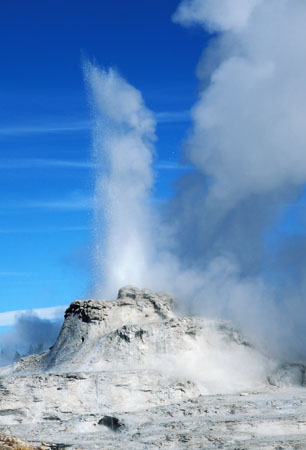 As with other subjects, a good starting point for successful images is a basic understanding of the subject. Ask not only what nature done, but also how, why and over what period. Only then can a photographer hope to portray natural phenomena in a manner that may arouse the interest of others.
As with other subjects, a good starting point for successful images is a basic understanding of the subject. Ask not only what nature done, but also how, why and over what period. Only then can a photographer hope to portray natural phenomena in a manner that may arouse the interest of others.
In the case of geysers it is worth waiting to catch the eruption. Some are quite predictable, other less so, but all have a history that should be consulted to reduce waiting time. Think about the direction of the light and wind, the anticipated height of the eruption, and how the ejected water and steam will behave. There is usually plenty of time to set up a camera and tripod in a suitable position and work out which lens to use.
River gorges are carved by the action of the fast-moving water that flows through them. Try to capture a sense of its speed and power, and the depth of the resulting gorge. Consider using slow shutter speeds to blur the moving water, and try to capture the nature and gradient of the enclosing cliffs.
Ox-bow lakes are probably best photographed from the air. The main river should be included in images where possible as this helps to explain to the viewer the process of their creation. The still waters of the ox-bow lake can also be contrasted with the flowing water of the main waterway.
Natural arches occur in a number of places around the world and are remarkable because it seems impossible that they have been created by nature. Some seem to defy gravity as they soar hundreds of feet above the ground. Look for good light, such as the warm colours of sunrise or sunset, and try to include some hint of the creation process – usually a combination of water, frost and wind erosion.
Stromatolites are layered limestone deposits formed by the growth of blue-green algae. They form hummocks or domes in shallow lagoons where evaporation causes high levels of salinity. In Shark Bay, Western Australia, where the best examples are found, they occur in such abundance that a mat-like structure is formed. Try to capture something of the environment in which they develop as well as the nature of the individual stromatolites.